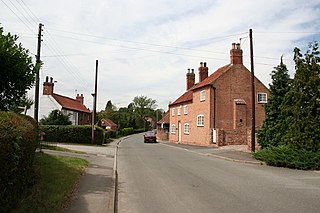
Belstone is a small village and civil parish in the West Devon District of Devon, England.

Grampound with Creed is a civil parish in Cornwall, England, United Kingdom.

Bitton is a village and civil parish of South Gloucestershire in Gloucestershire, England, to the east of Bristol and on the River Boyd.

Bude–Stratton is a civil parish in Cornwall, England, United Kingdom. The largest settlement in the parish is the seaside town of Bude. The parish also includes the market town of Stratton and the settlements of Flexbury, Poughill, Bush, Maer and Northcott north of Bude, and Upton, Lynstone, Thorne and Hele south of Bude.

Tedburn St Mary is a village and civil parish in the Teignbridge district of Devon, England, approximately 8 miles west of Exeter. According to the 2021 census, it had a population of 1,550, which was slightly more than the 1,472 recorded at the 2011 census. The village is the principal population centre of the electoral ward called Teignbridge North. The population of the ward at the 2011 census is 2,715.

St Sampson is a civil parish in mid-Cornwall, England, United Kingdom. The population at the 2011 census was 260.

Upton Bishop is a small village in Herefordshire, England. The population of the village at the 2011 census was 602.

Upton is a civil parish north-east of Kislingbury and south-west of Dallington, in Northamptonshire, England about 3.5 miles (6 km) west of Northampton town centre along the A4500 road. Formerly a scattered hamlet, it is now part of the town. The area west of Northampton is now a major area of expansion of the town and named Upton after the parish.

Upton is a small village in the English county of Nottinghamshire. It is located north of Askham and south of Headon; with the latter it forms the civil parish of Headon cum Upton. The population of this civil parish at the 2011 census was 253.

Upton is a village in the civil parish of Upton and North Elmsall, in the City of Wakefield, West Yorkshire, England. The parish had a population of 3,541 in the 2001 census.

Towan is found in many placenames in Cornwall. However, The Towans usually refers to the three-mile (5 km) stretch of coastal dunes which extends north-east from the estuary of the River Hayle to Gwithian beach with a midpoint near Upton. The South West Coast Path crosses the towans.

Brampford Speke is a small village in Devon, 4 miles (6 km) to the north of Exeter. The population is 419. It is located on red sandstone cliffs overlooking the river Exe. Its sister village of Upton Pyne lies to its southwest, and Stoke Canon is across the river, to the east. To the south is the hamlet of Cowley with its chapel of ease, which was formerly part of the ecclesiastical parish of Brampford Speke.

Cheriton Bishop is a village and civil parish situated on the northern borders of Dartmoor National park between Exeter and Okehampton, within Mid Devon District, Devon, England. The population at the 2021 Census was 754. The history of the settlement can be traced back over a thousand years when the old village centre was established as a commercial centre for the local farming community.

Linkinhorne is a civil parish and village in southeast Cornwall, England, United Kingdom. The village itself is situated at grid reference SX 320 736 and is approximately four miles (6.5 km) northwest of Callington and seven miles (11 km) south of Launceston. The parish population at the 2011 census including Downgate was 1,541

Cowley is a hamlet in the parish of Upton Pyne in Devon, England.

Kexby is a small village and civil parish in the West Lindsey district of Lincolnshire, England. The population of the civil parish at the 2011 census was 340. It lies at the side of the B1241 road, and is situated 4 miles (6 km) south-east of Gainsborough and 11 miles (18 km) north-west of the city and county town of Lincoln.
Maker-with-Rame is a civil parish in Cornwall, England, United Kingdom. It is situated on the Rame Peninsula, approximately four miles (6.5 km) south of Saltash and two miles (3 km) west of Plymouth.

North Tamerton is a village and civil parish in east Cornwall, England, UK. The village is situated approximately eight miles (13 km) southeast of Bude and eight miles (13 km) north of Launceston.

Otterham is a village and a civil parish in north Cornwall, England, United Kingdom. The village is situated approximately ten miles (16 km) south of Bude and six miles (9.7 km) north of Camelford.

St Dominic is a civil parish and village in Cornwall, England, United Kingdom. The village is situated 2+1⁄2 miles (4.0 km) east of Callington and five miles (8 km) north of Saltash.



















